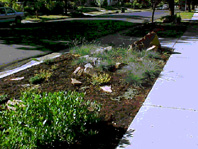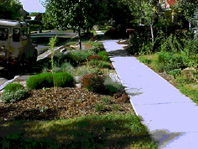Park Strips: More than Just Grass
Stephanie Duer, Water Conservation Coordinator Salt Lake City Department of Public Utilities
|
There are a number of reasons park strips are so difficult to maintain. Frequently the space is very narrow, even as narrow as 18 inches. Every winter they receive piles of snow or salt, and every summer blistering heat reflects from the asphalt roadway. People walk through them, cars run over them, and dogs use them. Designing and installing an efficient irrigation system that waters a space so narrow seems near to impossible. But there is an alternative to the traditional grass strip, and it requires less water and less maintenance, tolerates people and pets, and is interesting and attractive. Why not try a water-wise park strip?
City ordinance allows the planting of non-turf type plants in park strips, as long as the following simple guidelines are met:
- Groundcovers, shrubs, perennials, and annuals are not to exceed 18 inches in height when located within sightlines of streets, sidewalks, and driveways
- Annuals and perennials up to 36 inches in height may be used as individual specimens or accents, and when not located within sight lines to streets, driveways and sidewalks
- Plants must comprise at least 33 percent of the area of the park strip
- Bark, mulch, stepping or paving stones may be used in the remaining 67 percent of the space
- No excavation within 18 inches of an existing tree
- Poured concrete and asphalt are not permitted
- No plants with thorns, and no structural encroachments
But what to plant, you may wonder? Well, the possibilities are vast as shown on the table below. The table offers just a few suggestions.
So, now, as you stroll down the street, envision a landscape with beautiful, drought resistant trees and sidewalks lined with bright and cheery drought tolerant flowers. It promises a walk you’ll never forget.
|

